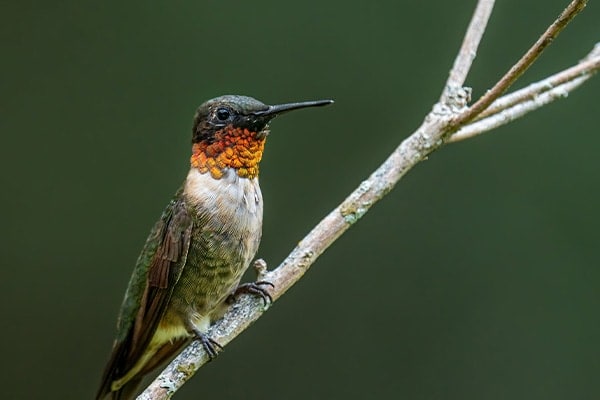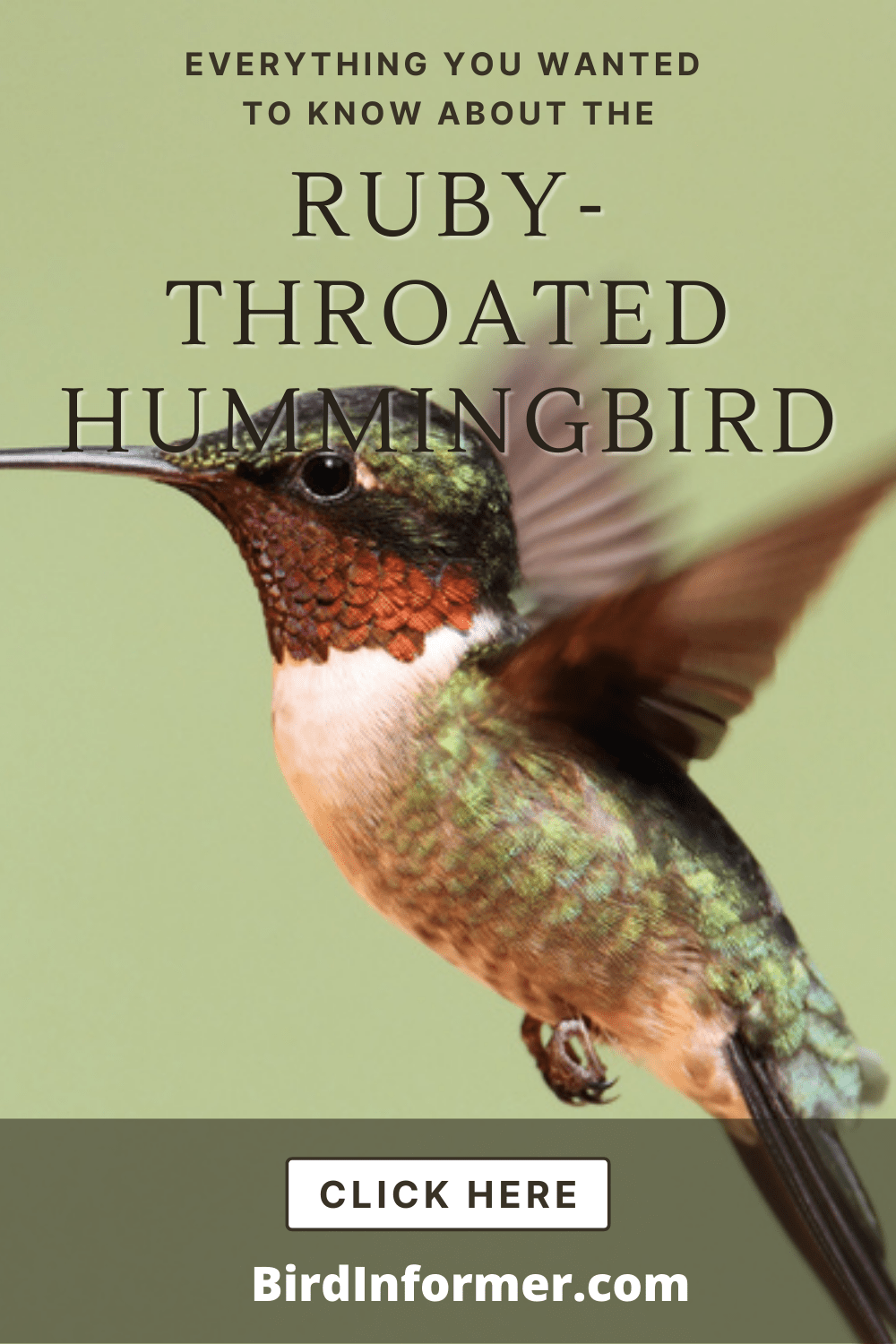Contents [show]
The Ruby-throated Hummingbird is a small-sized hummingbird with a beautiful color pattern of green and red. They are acrobatic birds known to be impressive and fast flyers. They are easily attracted to the color red, especially red and orange flowers.
In this article, we are going to cover a wide variety of topics related to the Ruby-throated Hummingbird, such as:
- How to identify them
- How, when, and where they migrate
- Their diet
- How and where they nest
- And much more…
So, without any more delay…
Let’s jump right into it and learn more about the Ruby-throated Hummingbird.
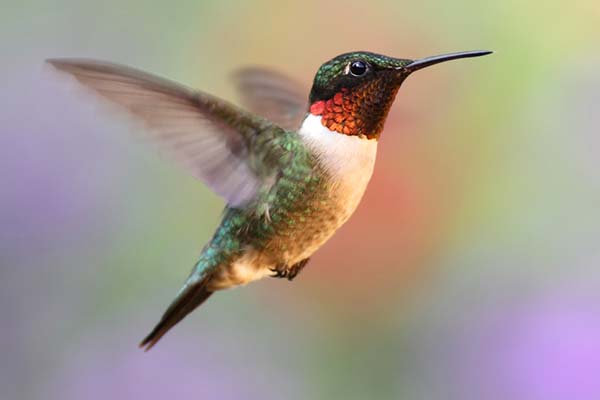
Ruby-throated hummingbird facts
- Common Name: Ruby-Throated Hummingbird
- Scientific Name: Archilochus colubris
- Scientific Family: Trochilidae
- Life Span: 6 years
- Size: 2.8 to 3.5 inches
- Wingspan: 3.1 to 4.3 inches
- Weight: 0.1 to 0.2 oz
- Conservation status: Least Concern (LC)
Ruby-throated hummingbird: how-to identify
Ruby-throated Hummingbirds are tiny hummingbirds that weigh only 2-6 grams. It is said that you’d need 10 Ruby-throated Hummingbirds to balance one loaf of bread, and this speaks a lot about how small they are.
Males and female Ruby-throated hummingbirds have different color patterns. Both have a long, slender, and slightly curved bill, bright green-color from their heads to their backs, and grayish-white underparts with a hint of green on the sides.
Differences Between Male & Female
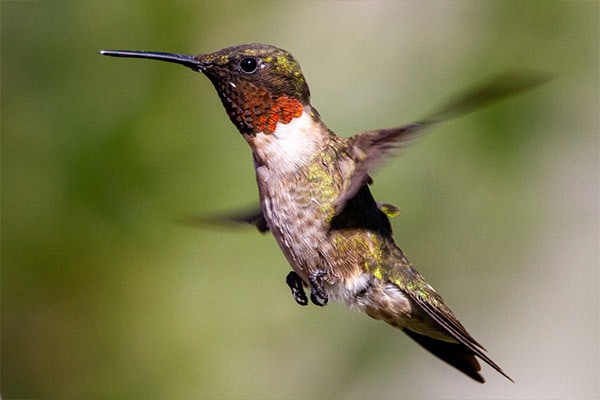
Male and female Ruby-throated Hummingbirds look the same overall with their iridescent green head and back. You’ll notice the difference in the throat area and the tail.
Male Ruby-throated Hummingbirds, as the name implies, have a ruby-red throat that sometimes looks black when light doesn’t shine on it. Females, on the other hand, have a plain throat. The male birds’ tail area is forked, while the females are square with a white tip.
Differences In Summer Plumage vs Winter Plumage
There’s no significant difference between the Ruby-throated Hummingbird’s summer and winter plumage. However, the birds do molt once a year before migration starts. You will notice that their heads and the feathers around their beak molts and turns dark.
Ruby-throated hummingbird bird vocalization
Where You’ll See Ruby-Throated Hummingbirds
Ruby-throated Hummingbirds are widespread across North America, breeding in Canada and other eastern states, then wintering in Central America, Mexico, and Florida.
These birds are commonly found in deciduous woodland areas, pine forests, and forest edges in summer. They are also common in backyards, gardens, and city parks. While in winter, they find shelter in citrus groves, tropical deciduous forests, shrubs, and even along a stream.
Ruby-throated hummingbird bird migration
Ruby-throated Hummingbirds are considered medium to long-distance migratory birds. They breed in the eastern United States and southern Canada, then fly south for winter to Central America and south of Mexico.
Before migration, these birds eat a lot for their long travels. They also fly fast, with some birds crossing the Gulf of Mexico in just over 24 hours. They also don’t travel in flocks but would instead fly alone, especially when they’re going back to their breeding grounds.
Ruby-throated hummingbird diet
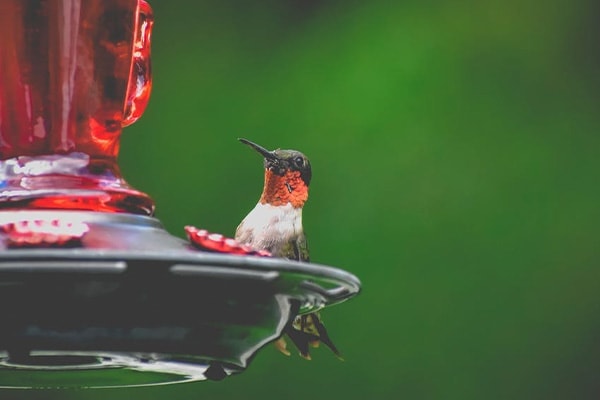
Ruby-throated Hummingbirds are omnivores, eating nectar and insects. A few of their favorite flowers to sip nectar from are red or orange tubular flowers like honeysuckle, red morning glory, and cardinal flowers. When there’s no nectar available, they will opt to go to feeders or sometimes feed on tree saps.
These birds also eat insects by sometimes catching them mid-air or pulling them from spider webs. This includes mosquitoes, fruit flies, small bees, and even spiders. They also sometimes eat caterpillars and aphids.
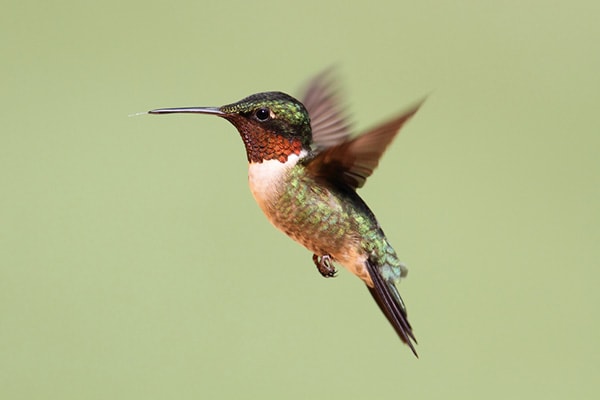
Ruby-throated hummingbird nesting
- Clutch Size: 1-3 eggs
- # of Broods: 1-2 broods
- Incubation Period: 12-14 days
- Nestling Period: 18-22 days
- Egg Description: Tiny, white, weighting about half a gram, or less than one-fiftieth of an ounce
Ruby-throated Hummingbirds are considered polygamous birds. There are even times when females have multiple mates, or both the male and the female will have other mates. So, there’s just no single pair, and after the whole duration of breeding, they go separate ways.
Males usually arrive first in the breeding area, and once females arrive, courtship starts with the male bird flying like a pendulum in front of the female. Once a pair is formed, the female chooses a nest site and starts constructing the nest.
Nests are usually built on slender and descending branches of deciduous trees. It’s usually at the height of 5-50 feet above the ground. And there are cases where they build their nests on large shrubs.
The nest is almost the size of a large thimble made of plant materials, spider webs, and pine resin. And since it’s placed on top of a branch rather than the fork of the branch, the female stamps on the base, so it’s stiff. After that, she’ll camouflage the nest with lichens and dead leaves to protect it from predators.
Parental care is given by females, while males usually just leave and do not provide any assistance.
Ruby-throated hummingbird behavior
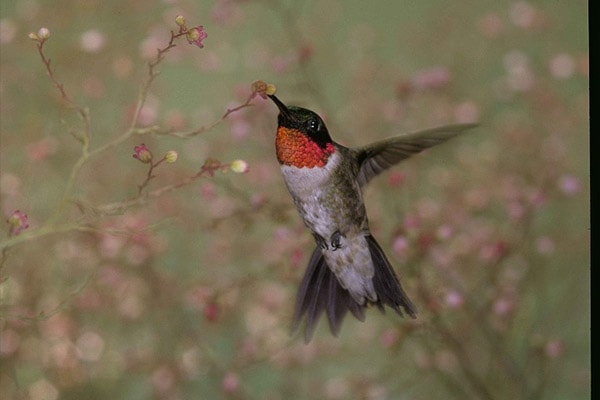
Ruby-throated Hummingbirds are solitary birds. They don’t migrate in flocks nor forage for food in flocks. The only time these birds will interact with each other is during mating. But after that, they all go their separate ways.
These birds are also diurnal, spending most of their day looking for food, especially during summer. But when the temperature drops, the birds can save their energy through hypothermic torpor, which slows down their body functions.
Another thing you’ll notice about Ruby-throated Hummingbirds is that they are amazing flyers. They are considered acrobatic, from flying backward to even sidewards or a wave. They can even fly so fast and stop in an instant, and one impressive flying is when they hover in the air.
Male Ruby-throated Hummingbirds are incredibly aggressive. They usually communicate through sounds, and when the intruder doesn’t leave the territory after a warning, he chases them.
How-to attract ruby-throated hummingbirds
Ruby-throated Hummingbirds are fairly easy to attract. All you need are the right flowers and bird feeders in your backyard.
These birds love red and orange flowers, so if you’re using bird feeders, choose one that is bright red. Hummingbird feeders are already designed this way; you just have to fill it up with a nectar solution.
But, if you want something more natural, you can plant tubular and trumpet-shaped flowers for the birds. Trumpet Honeysuckle is their favorite, but you can also plant cardinal flowers, field thistle, milkweed, jewelweed, sunflower, trumpet creeper, and more.
Provide the birds shelter by planting trees and shrubs, too. And as much as possible, don’t use pesticides in your garden so that the birds can also eat insects during the breeding season.
Ruby-throated hummingbird threats
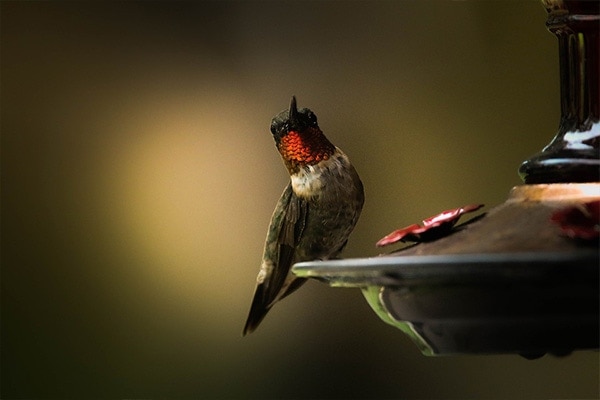
Due to their beautiful plumage and small size, these birds were hunted for collection purposes around the 19th century. Fortunately, the activity didn’t bring a tremendous effect on their numbers. And now, the population of Ruby-throated Hummingbirds has shown a steady increase.
Predators remain to be the greatest threat for these birds. Hawks, shrikes, and domestic cats are threats to adult Ruby-throated Hummingbirds, while Blue Jays are threats to their nestlings.
Ruby-throated hummingbird fun & interesting facts
- Ruby-throated Hummingbirds beat their wings rapidly, about 53 times in a second.
- These birds are easily attracted to the color red or orange.
- The birds have short legs that prevent them from hopping or walking.
- They are one of the smallest hummingbird species.
- They are the only breeding hummingbird in North America.
- These birds can cross over the Gulf of Mexico in just one flight.
- The oldest recorded Ruby-throated Hummingbird is 9 years and 1 month old.
- Rivoli’s Hummingbird
- Blue-throated Hummingbird
- Lucifer Hummingbird
- Ruby-throated Hummingbird
- Black-chinned Hummingbird
- Anna’s Hummingbird
- Costa’s Hummingbird
- Broad-tailed Hummingbird
- Rufous Hummingbird
- Allen’s Hummingbird
- Calliope Hummingbird
- Broad-billed Hummingbird
- Buff-bellied Hummingbird

